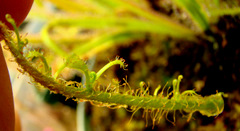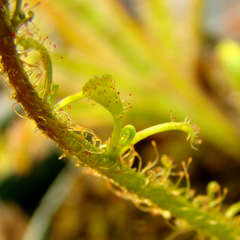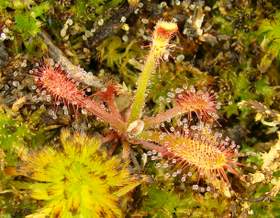South American Sundews
South American sundews are some of the most beautiful species of the Drosera genus.Unfortunately, they can be difficult for many people to grow. If you want to have success growing South American sundews, try to give them the following conditions:
- Cooler temperatures
Although South American sundews can
handle warmer temperatures, the ideal daytime range for most is from
65-75 degrees Farenheit. Some areas report 80 degrees F in nature. I've
given mine 85 degrees F before and as long as they have a nightime
temperature drop, they respond just fine (see paragraph below).
- Temperature drop at night
South American sundews need at least a
10 degree temperature drop to grow well. In nature, the temperature can
drop down to 45 or 50 degrees. My temperatures range from around 80
degrees F in the day to 70 F at night. This is a bit too warm for D.
ascendens, which is typically picky about temps. Also D. villosa was
able to handle 75 degree daytime temps for a while, but once it reached
80F+ it started to suffer. D. graomogolensis is extremely adaptable to
warmer temps. I'm very impressed after growing it in 85 degree F temps
for a month, and it now looks like the top-left picture above. Drosera
tomentosa also has grown well in 85 degree F temps, but for some reason
prefers to be grown in live sphagnum in warmer temps.
- Plenty of humidity
South American/ Brazilian sundews do
best for me when the humidity is above 75%.
Some growers give them nearly 100% humidity in terrariums, but this isn't necessary.
Some growers give them nearly 100% humidity in terrariums, but this isn't necessary.
- Feed them often, but only use small amounts
Although South American sundews love to
be fed, for some reason, the leaves tend to burn and become deformed if
they are fed amounts that are too large.
Wait until they color back up before feeding them a second time. S. American dews tend to produce less dew if they are fed too often.
Wait until they color back up before feeding them a second time. S. American dews tend to produce less dew if they are fed too often.
- Plenty of light
South American sundews can't seem to
get enough light. Mosst Brazilian sundews and other South
American sundews will turn bright red if they are given enough light.
They produce the most dew when they are this color.
- Tall pots
South American sundews have long roots,
so be sure to give them pots that are 6 inches (approx 16 centimeters)
or larger.
- Appropriate media
South American sundews can grow well in
a peat: sand mix for many people.
However, some growers only report success with live sphagnum. For younger plants, dead sphagnum has also been reported to be the best media. I have only tried peat:sand (great success) and live sphangum (best when roots are longer). I don't like using perlite, but it could help keep the soil moisture at a good level.
Just make sure that the media always stays moist. If you let it dry out too much, younger plants may not survive. Once the roots get longer, they will be much more tolerant of "droughts". When growing them in warmer temps, I've found that live sphagnum is best for most of these subtropical Drosera.
Propagation techniques for South
American sundews:
However, some growers only report success with live sphagnum. For younger plants, dead sphagnum has also been reported to be the best media. I have only tried peat:sand (great success) and live sphangum (best when roots are longer). I don't like using perlite, but it could help keep the soil moisture at a good level.
Just make sure that the media always stays moist. If you let it dry out too much, younger plants may not survive. Once the roots get longer, they will be much more tolerant of "droughts". When growing them in warmer temps, I've found that live sphagnum is best for most of these subtropical Drosera.
Leaf Cuttings:
South American sundews can be easy to
propagate, despite many people's reports. I believe that all Brazilian
and other South American sundews can be propagated via leaf cuttings.
The trick is keeping the leaves cooler while putting them as close to
growlights as possible. I have successfully propagated Drosera
graminifolia this way. Drosera ascendens and Drosera graomogolensis are
other sundews that have had positive reports with leaf cuttings.
Drosera meristocaulis has been reported as impossible, but after
attempting several pygmy Drosera leaf pullings, I think that it could
be possible, if you give the leaf pullings the ideal conditions to bud.


Above: Drosera graminifolia leaf cuttings
Root Cuttings:
This will work with most of the
thick-rooted South American sundews. Drosera graomogolensis and Drosera
ascendens are easy to propagate via root cuttings. Some species can be
trickier such as D. graminifolia. Drosera meristocaulis has been
reported as impossible with root cuttings.
Seeds:
Cold Stratification is not required. You can follow my seed germination guide for most South American sundew species. Cross
pollinate to produce the most
seeds. Most South American or Brazilian sundews need to be
cross-pollinated if you want them to produce a lot of seed (Drosera
graminifolia is one of the exceptions). Although they do produce a few
seeds if you self-pollinate your South American sundews, they will
produce several hundred to thousands of seeds when cross-pollinated.
The seeds have been reported to be larger, and more viable if
cross-pollinated as well. However, if you don't own a genetically
different plant, there is still a chance you could get good seed
production. Most people's growing conditions don't encourage
self-pollination for some reason. However, in nature, pretty much all
South American sundews are supposed to be self-fertile.
Drosera camporupestris seedlings and a Drosera roraimae seedling
Additional Questions or Suggestions?
Contact me at: sundewman(at)yahoo.com
